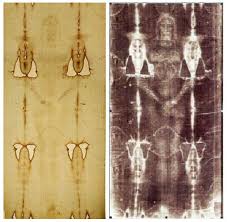
Throughout the middle Ages religious relics allegedly associated with Jesus, the Virgin Mary, or the Apostles were revered by pious but gullible men and women throughout Christendom and exploited by such unscrupulous rogues as the Pardoner in the Canterbury Tales by the 14th-century English poet Geoffrey Chaucer.
The Original Holy Turin Shroud
Among these relics there were several shrouds that were claimed by their devotees or owners to be the original burial cloth in which Jesus’ body had lain in Joseph of Arimathea’s tomb after being taken down from the cross. But unique among these shrouds was the one in the possession of the Dukes of Savoy (later, King of Italy), for it had upon it faint shadowy stains merging into one another which, from a distance, took on the outlines of a human figure lying with hands crossed.
Signs of Jesus
The stains were held to be the imprints of Jesus’ physical body miraculously preserved on the Savior’s burial cloth. The legend surrounding the shroud states that it was taken from Jerusalem to Constantinople, where it was seen in 1204. In 1353 Robert de Charny built an abbey for it at Chambery.
Then in 1578 it was taken to Italy so that the aged Archbishop of Milan should be spared the journey across the Alps to see it. It has remained there ever since safely stored in a silver casket in the Cathedral of Turin. It is still unique, for it is the only alleged religious relic that, instead of having been proved bogus by scientific investigation has on the contrary convinced many scientists that it must be genuine.
The question whether the “Holy Shroud of Turin” is an authentic artifact directly associated with the historical Jesus is one of the most intriguing of all religious mysteries; the more so because the full mystery has only emerged in the present century.
Secondo Pia’s Discovery
It was in 1898 that a Turin photographer named Secondo Pia was commissioned by king Humbert I of Italy, the “guardian” of the Shroud, to take the first-ever photographs of the holy burial cloth.
When he developed his photographic plates, Pia was astonished and at first thought that he must have made some mistake, for on his negative plate he saw not a reversed image of the brown stains but a picture of a bearded face wearing an expression of great serenity and nobility. Whereas the face visible on the Shroud was rather blurred and the features were ill-defined, the one on the plate was perfectly clear.
When he recovered from his initial astonishment, the photographer realized what must have happened. As the picture on his negative plate was a positive, he must have photographed a negative. Incredibly, the shadowy markings on the cloth were the opposite way round in term of light and shade, like a photographic negative.
Others were to puzzle over the problem of how this could be and propose various explanations, but it seemed to second Pia when he looked at his first negative plate that he had witnessed a miracle. It was as if the Holy Shroud had been waiting 19 centuries for man’s discovery of the art of photography to unlock its secret.
Further Investigations
When Secondo Pia’s discovery was announced and his photographs were made available for study, there were naturally people who suggested that a clever fake must have been perpetrated. More photographs were taken with the same results, which exonerated Pia, but it was now suggested that the shroud had been faked by a medieval artist who had painted the markings on it.
More Surprise
When this possibility was examined the mystery deepened. Microscopic examination showed that there were no deposits of paint on the fabric, every individual thread was distinctly visible, those that were stained were stained right through, and there were no outlines or shadings such as would be found on work done by human hand. Furthermore, not only was it technically impossible for an artist to have faked the image on the Shroud, but also nobody in the Middle Ages, when of course the principles of photography were unknown, could have conceived or executed the idea of reversing the light and shade and so imprinting a negative image on the Shroud.
No Forgery Verdict
The testimony of medical men also ruled out the possibility of medieval forgery. In those days knowledge of anatomy was rudimentary and nothing was known of the circulation of the blood, but the markings on the Shroud are exact in anatomical detail and proportion and the authenticity of marks made by blood flowing from the wounds is confirmed by forensic medicine, which has shown those marks to be consistent with the known behavior of shed blood.
Forensic examination has, moreover, confirmed the gospel accounts of the execution of Jesus. The dark stains on the shroud that come up white on the photograph clearly show wounds on the left wrist (the right one is covered by the left hand), on the soles of the feet, on the right breast, on the brow and all over the back, which respectively bear out the story that Jesus was crucified, pierced by a Roman soldier’s lance, crowned with a crown of thorns, and scourged. Medical men have also noted that the expanded rib cage and the drawn in hollow below it indicate that the man of the Shroud died while hanging by the arms.
To be cont…